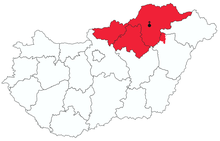Hungarian Catholic Eparchy of Miskolc
The Hungarian (Greek) Catholic Eparchy of Miskolc is an eparchy (Eastern Catholic diocese) of the Hungarian Greek Catholic Church (Latin Miskolcensis), a Metropolitan particular church sui juris which uses the Byzantine Rite in the Hungarian language.
Diocese of Miskolc Dioecesis Miskolcensis Miskolci egyházmegye | |
|---|---|
 Cathedral of the diocese | |
| Location | |
| Country | |
| Ecclesiastical province | Hungarian Greek Catholic Church |
| Metropolitan | sui iuris |
| Population - Catholics | 50,000 |
| Information | |
| Rite | Byzantine Rite |
| Cathedral | Cathedral of the Assumption in Miskolc |
| Current leadership | |
| Pope | Francis |
| Bishop | Atanáz Orosz |
| Metropolitan Archbishop | Péter Fülöp Kocsis |
| Map | |
 Territory of the Eparchy of Miskolc | |
| Website | |
| Website | |
It is a suffragan of the Hungarian Catholic Archeparchy of Hajdúdorog, a Metropolitanate sui juris and the Hungarian Catholics' only province, entirely in Hungary and depending on the Roman Congregation for the Oriental Churches.
Its cathedral episcopal see is Nagyboldogasszony püspöki székesegyház, in Miskolc, in Borsod-Abaúj-Zemplén (northeastern Hungary).
History
- It was established on 4 June 1924 as Apostolic Exarchate of Miskolc, an Eastern Catholic missionary pre-diocesan jurisdiction (comparable to a Latin Apostolic Prefecture or here rather to an Apostolic Vicariate as all incumbents held titular sees) on territory previously only served by the Latin church.
- On 5 March 2011 it gained territory from the then Hungarian Catholic Eparchy of Hajdúdorog, now its Metropolitan.
- On 20 March 2015 it was promoted as Eparchy (Diocese) of Miskolc and became suffragan of the simultaneously elevated Metropolitan Archeparchy (Archdiocese) of Hajdúdorog, which also became the newly created Eparchy of Nyiregyháza's Metropolitan.
Episcopal Hierarchs
- Apostolic Exarchs of Miskolc
- Antal Papp (1924.07.14 – 1945.12.24) (born Ukraine), Titular Archbishop of Cyzicus (1924.07.14 – 1945.12.24); previously Titular Bishop of Lyrba (1912.04.29 – 1912.06.02) & Coadjutor Eparch of Mukacheve of the Ruthenians (Ukraine) (1912.04.29 – 1912.06.02), succeeding as Eparch (Bishop) of Mukacheve of the Ruthenians (1912.06.02 – 1924.07.14)
- Miklós Dudás, Basilian Order of Saint Josaphat (O.S.B.M.) (1946.10.14 – 1972.07.15), while Eparch (Bishop) of Hajdúdorog of the Hungarians (Hungary) (1939.03.25 – 1972.07.15)
- Imre Timkó (1975.01.07 – 1988.03.30), while Eparch of Hajdúdorog of the Hungarians (Hungary) (1975.01.07 – 1988.03.30)
- Szilárd Keresztes (1988.06.30 – 2007.11.10), while Bishop of Hajdúdorog of the Hungarians (Hungary) (1988.06.30 – 2007.11.10); previously Titular Bishop of Chunavia (1975.01.07 – 1988.06.30) & Auxiliary Eparch of Hajdúdorog of the Hungarians (Hungary) (1975.01.07 – 1988.06.30); later Apostolic Administrator of Hajdúdorog of the Hungarians (2007.11.10 – 2008.05.02)
- Apostolic Administrator Péter Fülöp Kocsis (2008.05.02 – 2011.03.05), while Eparch of Hajdúdorog of the Hungarians (Hungary) (2008.05.02 – 2015.03.20), later promoted its first Archeparch (Metropolitan of Hajdúdorog of the Hungarians) (2015.03.20 – ...), President of Council of the Hungarian Church (2015.03.20 – ...)
- Atanáz Orosz (2011.03.05 – 2015.03.20 see below), Titular Bishop of Panium (2011.03.05 – 2015.03.20)
- Suffragan Eparchs (Bishops) of Miskolc
- Atanáz Orosz (see above 2015.03.20 – ...), also Apostolic Administrator of Nyíregyháza of the Hungarians (Hungary) (2015.03.20 – 2015.10.31).
Statistics and extent
As per 2014, it pastorally served 51,100 Hungarian (Byzantine rite) Catholics in 62 parishes and 10 missions with 71 priests (diocesan) and 21 seminarians.
The eparchy covers three Hungarian comitat (counties) : Borsod-Abaúj-Zemplén, Heves and Nógrád, plus part of Hajdúnánás.
Since 2012,[1] the then exarchate include 59 parishes (in Hungarian : parókia) grouped in six vicariates : Abod, Edelény, Irota, Kazincbarcika, Múcsony, Ózd, Rakaca, Rakacaszend, Sajószentpéter, Szuhakálló, Viszló, Baktakék, Csobád, Encs, Felsővadász, Gadna, Garadna, Homrogd, Kány, Mogyoróska, Pere, Selyeb, Szikszó, Abaújszántó, Baskó, Bekecs, Bodrogkeresztúr, Bodrogolaszi, Boldogkőváralja, Komlóska, Mezőzombor, Szerencs, Tokaj, Tolcsva, Miskolc-Avas, Miskolc (-Belváros), Miskolc-Diósgyőr, Miskolc-Görömböly, Miskolc-Szirma, Arnót, Berzék, Eger, Emőd, Felsőzsolca, Hejőkeresztúr, Sajópálfala, Sajópetri, Sajóvámos, Szirmabesenyő, Tiszaújváros, Alsóregmec, Dámóc, Filkeháza, Kenézlő, Mikóháza, Pácin, Rudabányácska, Sárospatak, Sárospatak-Végardó, Sátoraljaújhely, Vajdácska and Zemplénagárd.
See also
References
- (in Hungarian) Miskolci Apostoli Exarchátus múltja és jelene sur www.exarchatus.gportal.hu (consulté le 6 novembre 2013)